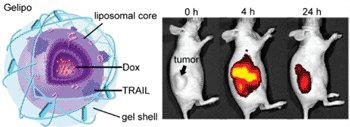Nanoparticle Co-Delivery of a Membrane-Associated Protein and a Small-Molecule Anticancer Drug Enhanced Therapeutic Efficacy in a Mouse Model
By LabMedica International staff writers
Posted on 23 Jan 2014
Combining two anticancer drugs within a novel targeted nanoparticle overcomes their shortcomings and forms the basis for a new therapeutic agent with improved inhibition of tumor growth in a mouse xenograft- tumor model.Posted on 23 Jan 2014
A team of investigators at North Carolina State University (Raleigh, USA) and the University of North Carolina (Chapel Hill, USA) sought to improve the performance of the cancer drugs doxorubicin (Dox) and tumor necrosis factor-related apoptosis-inducing ligand (TRAIL).

Image: The structure of the nanoparticle (left) and how the nanoparticles home in on a tumor and shrink it (right) (Photo courtesy of North Carolina State University).
Although in use for more than 40 years as a primary chemotherapy drug, Dox is known to cause serious heart problems. To prevent these, doctors may limit the amount of Dox given to each patient so that the total amount a patient receives over her or his entire lifetime is 550 milligrams per square meter, or less. Furthermore, the necessity to stop treatment to protect the patient from heart disease may diminish the usefulness of Dox in treating cancer. TRAIL is a cytokine that is produced and secreted by most normal tissue cells. It causes apoptosis primarily in tumor cells by binding to certain death receptors. Since the mid-1990s, it has been used as the basis for several anticancer drugs, but has not been found to have any significant survival benefit.
To optimize the action of the two drugs, the investigators created a core and shell-based “nanodepot” consisting of a liposomal core and a crosslinked hyaluronic acid (HA)-based gel shell (designated Gelipo). Since it is a small-molecule drug intercalating the nuclear DNA, Dox was loaded in the aqueous core of the liposome. TRAIL, which acts on the death receptor (DR) on the plasma membrane, was encapsulated in the outer HA shell.
Following injection of the nanoparticles into mice carrying the MDA-MB-231 xenograft tumor, the HA shell was degraded by the hyaluronidase (HAase) enzyme that was concentrated in the tumor environment. This resulted in the rapid extracellular release of TRAIL and subsequent internalization of the liposomes, which caused release of Dox within the tumor cells.
Results published in the January 2, 2014, online edition of the journal Advanced Functional Materials revealed that the parallel activity of TRAIL and Dox showed synergistic anticancer efficacy, with the Dox-TRAIL nanoparticles being 5.9 times more effective than nanoparticles loaded only with Dox.
“In testing on laboratory mice, our technique resulted in significant improvement in breast cancer tumor reduction as compared to conventional treatment techniques,” said senior author Dr. Zhen Gu, assistant professor in the joint biomedical engineering program at North Carolina State University and the University of North Carolina.
“Cancer cells can develop resistance to chemotherapy drugs, but are less likely to develop resistance when multiple drugs are delivered simultaneously. However, different drugs target different parts of the cancer cell. For example, the protein drug TRAIL is most effective against the cell membrane, while doxorubicin (Dox) is most effective when delivered to the nucleus. We have come up with a sequential and site-specific delivery technique that first delivers TRAIL to cancer cell membranes and then penetrates the membrane to deliver Dox to the nucleus.”
“This research is our first proof of concept, and we will continue to optimize the technique to make it even more efficient,” said Dr. Gu. “The early results are very promising, and we think this could be scaled up for large-scale manufacturing.”
Related Links:
North Carolina State University
University of North Carolina














